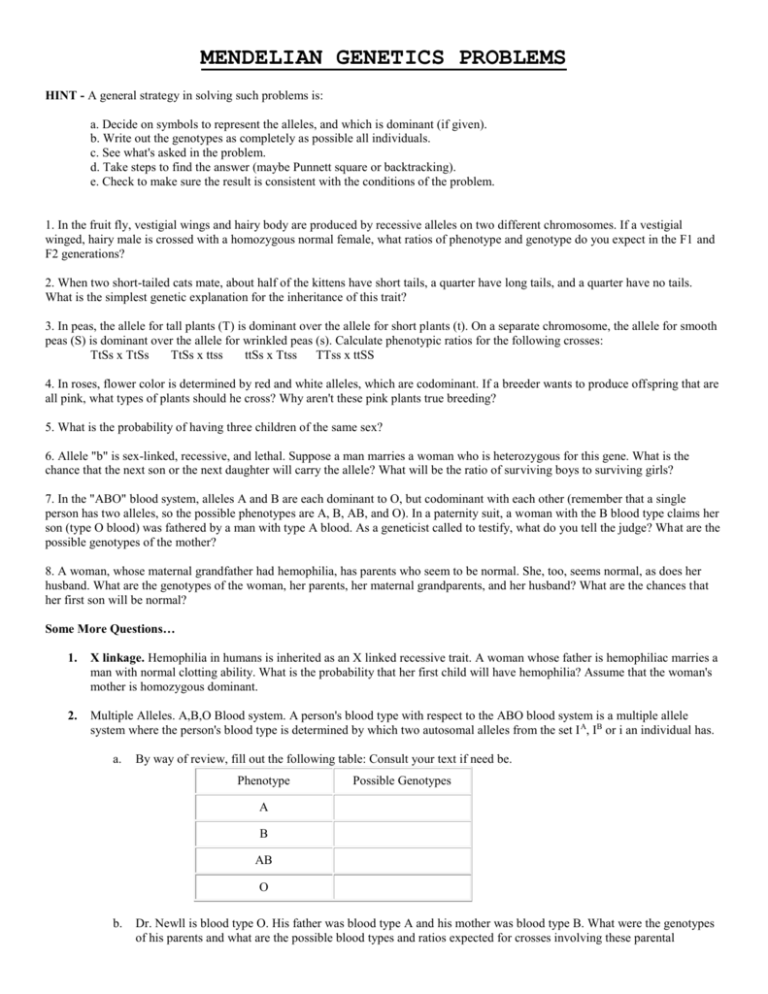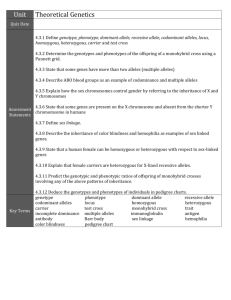Genetics Puzzles
advertisement

MENDELIAN GENETICS PROBLEMS HINT - A general strategy in solving such problems is: a. Decide on symbols to represent the alleles, and which is dominant (if given). b. Write out the genotypes as completely as possible all individuals. c. See what's asked in the problem. d. Take steps to find the answer (maybe Punnett square or backtracking). e. Check to make sure the result is consistent with the conditions of the problem. 1. In the fruit fly, vestigial wings and hairy body are produced by recessive alleles on two different chromosomes. If a vestigial winged, hairy male is crossed with a homozygous normal female, what ratios of phenotype and genotype do you expect in the F1 and F2 generations? 2. When two short-tailed cats mate, about half of the kittens have short tails, a quarter have long tails, and a quarter have no tails. What is the simplest genetic explanation for the inheritance of this trait? 3. In peas, the allele for tall plants (T) is dominant over the allele for short plants (t). On a separate chromosome, the allele for smooth peas (S) is dominant over the allele for wrinkled peas (s). Calculate phenotypic ratios for the following crosses: TtSs x TtSs TtSs x ttss ttSs x Ttss TTss x ttSS 4. In roses, flower color is determined by red and white alleles, which are codominant. If a breeder wants to produce offspring that are all pink, what types of plants should he cross? Why aren't these pink plants true breeding? 5. What is the probability of having three children of the same sex? 6. Allele "b" is sex-linked, recessive, and lethal. Suppose a man marries a woman who is heterozygous for this gene. What is the chance that the next son or the next daughter will carry the allele? What will be the ratio of surviving boys to surviving girls? 7. In the "ABO" blood system, alleles A and B are each dominant to O, but codominant with each other (remember that a single person has two alleles, so the possible phenotypes are A, B, AB, and O). In a paternity suit, a woman with the B blood type claims her son (type O blood) was fathered by a man with type A blood. As a geneticist called to testify, what do you tell the judge? What are the possible genotypes of the mother? 8. A woman, whose maternal grandfather had hemophilia, has parents who seem to be normal. She, too, seems normal, as does her husband. What are the genotypes of the woman, her parents, her maternal grandparents, and her husband? What are the chances that her first son will be normal? Some More Questions… 1. X linkage. Hemophilia in humans is inherited as an X linked recessive trait. A woman whose father is hemophiliac marries a man with normal clotting ability. What is the probability that her first child will have hemophilia? Assume that the woman's mother is homozygous dominant. 2. Multiple Alleles. A,B,O Blood system. A person's blood type with respect to the ABO blood system is a multiple allele system where the person's blood type is determined by which two autosomal alleles from the set I A, IB or i an individual has. a. By way of review, fill out the following table: Consult your text if need be. Phenotype Possible Genotypes A B AB O b. Dr. Newll is blood type O. His father was blood type A and his mother was blood type B. What were the genotypes of his parents and what are the possible blood types and ratios expected for crosses involving these parental genotypes? 3. Independent assortment. Pretend that a couple with the same blood type genotypes as Dr. Paul's parents want to have a child. The mother happens to be a carrier of hemophilia. a. What is the probability that their first child will be type AB and have hemophilia? b. The parents conceive, and amniocentesis reveals that the child is male. Recalculate your probability in A given this new information. Hints: the hemophilia locus is on the X chromosome and the ABO blood system locus is on an autosome so we can use Mendel's law of independent assortment. Write the cross as a combination of two independent single locus crosses, one for blood type and one for the hemophilia locus. 4. Incomplete dominance and codominance. A snapdragon pure breeding for red flowers is bred with one for white flowers. The F1 generation flowers are all pink. What would you predict for the phenotypic ratios for the F2 generation? Assume that this trait is controlled by two alleles at a single locus. Note typically the alleles are represented with superscripted capital letters similar to what we did for the ABO blood system. Note that the genotype and phenotype ratio is the same! 5. Explain the difference between incomplete dominance and codominance. 6. An odd case: Viable dominant but recessive lethal In mice, the yellow coat color never breeds true. When yellow mice are bred to non-yellow mice the progeny show a 1 : 1 ratio of yellow to non yellow mice. When two yellow mice are bred together a phenotypic ratio of about 2 yellow to 1 non-yellow is typically observed.. What might be going on here? Pedigrees – explain the inheritance pattern for each pedigree






